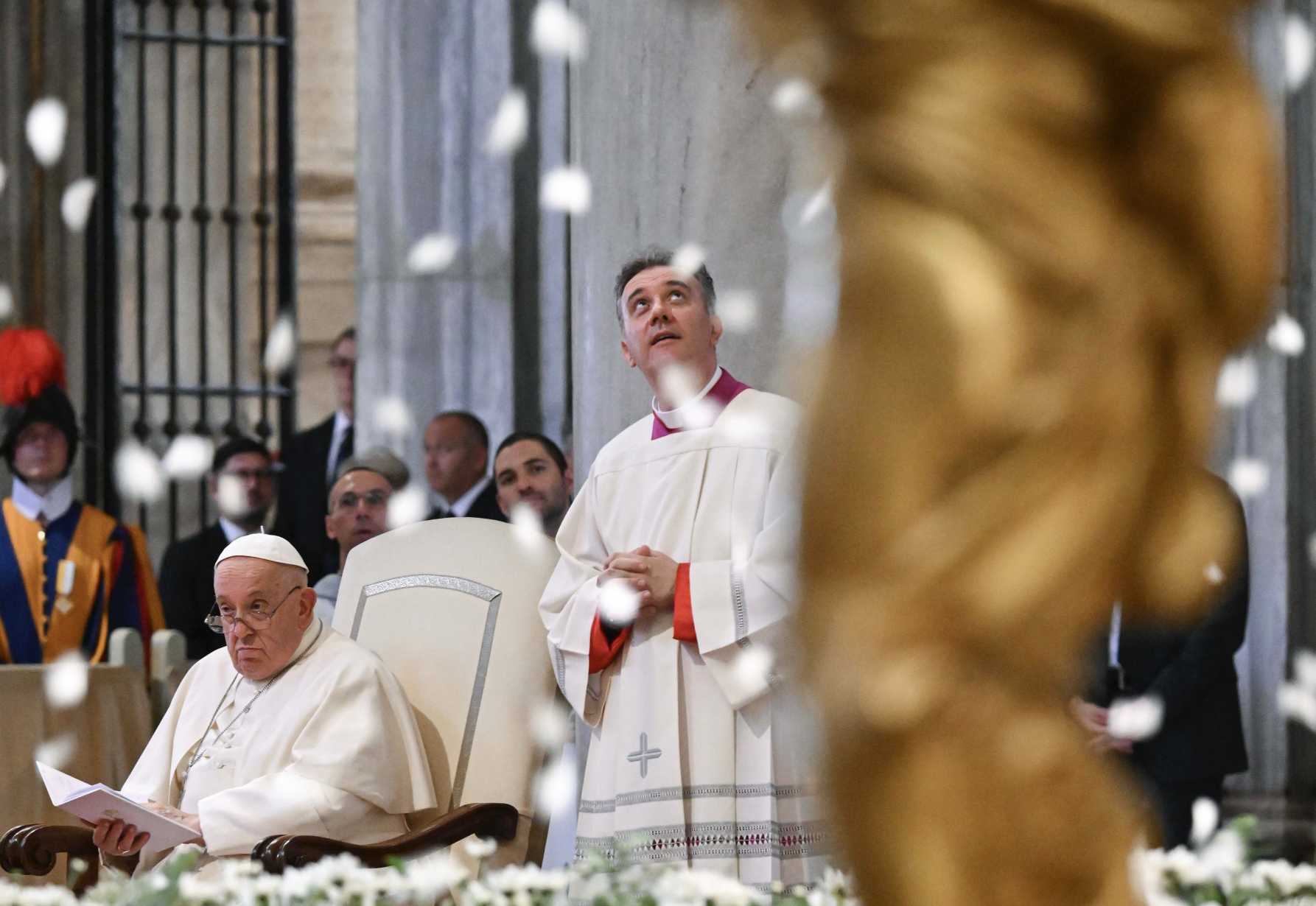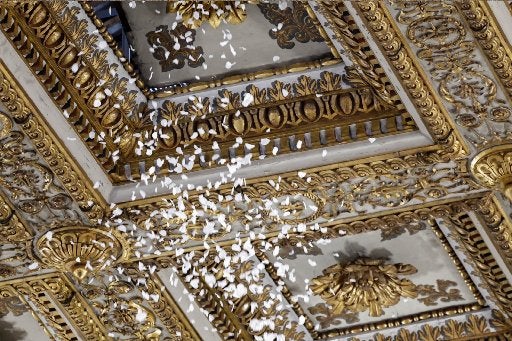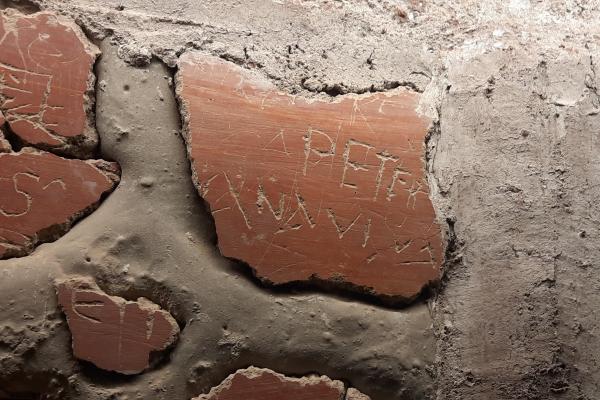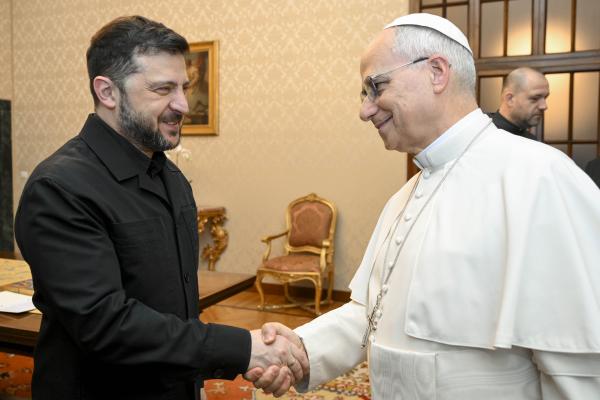Grace arouses marvel and awe, like a summer snowfall would, pope says
Pope Francis marked the feast of the dedication of Rome's Basilica of St. Mary Major and the feast of Our Lady of the Snows by preaching at an evening prayer service and watching rose petals fall from the ceiling to invoke an ancient miracle.
 Cindy Wooden
Cindy Wooden

Pope Francis and an aide watch as white rose petals fall from the ceiling of Rome's Basilica of St. Mary Major on the Aug. 5 feast of the basilica's dedication. The petals are meant to evoke snowfall, because, according to tradition, on Aug. 5, 358, Mary had snow fall to mark the spot on Rome's Esquiline Hill where she wanted the church built in her honor. (CNS photo/Vatican Media)
ROME (CNS) -- Whether or not Mary caused snow to fall in Rome on a summer day more than 1,600 years ago, Christians know that God's grace is always undeserved, always beautiful and literally awesome, Pope Francis said.
Celebrating the feast of the dedication of Rome's Basilica of St. Mary Major and the related feast of Our Lady of the Snows Aug. 5, the pope watched a snowfall of white rose petals fall from the basilica's coffered ceiling.
According to tradition, on Aug. 5, 358, Mary had the snow fall to mark the spot on Rome's Esquiline Hill where she wanted a church built in her honor. The event is marked each Aug. 5 with flower-petal precipitation during the singing of the Gloria at Mass and again with the singing of the Magnificat at evening prayer.
A note from the Vatican said that already during the first millennium, the celebration of the feast day was accompanied "by an evocative use of perfumed white petals scattered around the basilica." Now they are dropped from a hole in the basilica's ceiling and then collected by pilgrims and tourists.
Pope Francis is a frequent visitor to the basilica -- going to pray before the basilica's Marian icon "Salus Populi Romani" before and after every foreign trip.

In a book co-written by the pope and published in March, the 87-year-old Pope Francis said that while he has no intention of resigning, if he were seriously impaired, he would resign and would live at St. Mary Major "to serve as a confessor and give Communion to the sick" rather than live at the Vatican. A few months earlier, he had revealed that he planned to be buried in the basilica.
In his homily during evening prayer on the feast day, Pope Francis spoke about the legendary snowfall, but focused more on the icon.
Pope Francis asked the congregation to think about a verse from the Book of Sirach, "which says the following about the snow that God causes to fall from the sky: 'The eye marvels at the beauty of its whiteness, and the mind is amazed at its falling.'"
As people's faces glistened with sweat and many used the prayer booklets to fan themselves, Pope Francis told them that snow is "a symbol of grace, that is, of a reality that combines beauty and gratuitousness."
"Grace cannot be deserved, let alone bought, it can only be received as a gift," he said. "As such, it is also totally unpredictable, just like a midsummer snowfall in Rome. Indeed, grace arouses marvel and amazement."
But Pope Francis also asked them to focus on the icon "Salus Populi Romani," which translates as "health -- or salvation -- of the Roman people."
Calling the icon "the gem" of the basilica, the pope said its simple depiction of Mary and the child Jesus shows grace "in its concreteness, stripped of every mythological, magical and spiritualistic vesture always lurking in the religious sphere."
Mary is "full of grace, conceived without sin, immaculate as the freshly fallen snow," he said. "The child holds the Holy Book with his left hand and blesses with his right; and the first one to be blessed is his mother, blessed among all women."
Mary's dark mantle "allows her son's golden garment to stand out," he said, communicating that "in him alone dwells all the fullness of divinity; and she, with uncovered face, reflects his glory."
Mary "is the mediatrix of the grace that always and only flows through Jesus Christ, by the action of the Holy Spirit," which is why generations of Christians have turned and continue to turn to her in prayer, he said.
Pope Francis invoked her intercession "for the city of Rome and for the whole world, particularly for peace, that peace which is true and lasting only when it flows from repentant and forgiven hearts; that peace which comes from the Cross of Christ, and from his blood that he took from Mary and shed for the remission of sins."
"Forgiveness makes peace," he said.

Summer snow in Rome? Pope explains ancient miracle
Pope Francis attends an evening prayer service at Rome's Basilica of St. Mary Major on the feast of the basilica's dedication, which is also the feast of Our Lady of the Snows.



